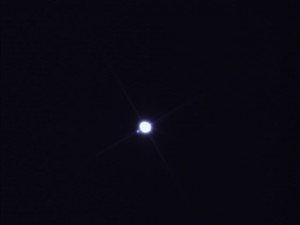by Dave Blane
You won’t need a finder chart to locate December’s double star. It’s the first magnitude star β Orionis, better known by its proper name Rigel. Seventh brightest star in the night sky, Rigel dazzles us with a diamond-white colour; especially striking when compared with Orion’s other first-magnitude star, the ruddy-hued Betelgeuse.
Many backyard astronomers are unaware that Rigel is a double star. Its companion (Rigel B) lies 9 arc-seconds away – a gap that should be easily breached by the smallest of telescopes. Unfortunately, it shines at magnitude 6.8, 400 times fainter than the primary. As a result, the little star often hides in the glare of its master. In 1822, the first reliable measure of the Rigel system indicated a separation of 8.9” and a position angle of 201deg, the latter meaning that Rigel B lay south and slightly west of the main star. Not much has changed in nearly two centuries. In 2004, the separation and P.A. had increased slightly to 9.4” and 204deg. Because Rigel A and B share a common proper motion, astronomers believe they form a physical binary separated by 2500 AU – a distance over 60 times greater than the gap separating Pluto from the sun. Their orbital period is thought to exceed 25,000 years. The last time Rigel B was in its current orbital position the earth was in the grip of the Ice Age! Because of the large disparity in brightness between its components,
Rigel can be quite difficult to split if the seeing is poor. The literature often suggests that a 150mm telescope is required to separate the pair but in the writer’s experience a 75 mm refractor will do the job on most nights. What is the smallest aperture that will split this pair? A report back from anyone achieving this with a 60mm (APO?) or smaller scope would be interesting.

